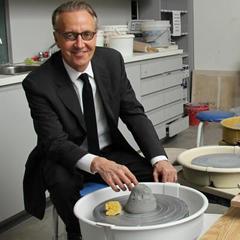As executive director and CEO of the Gardiner Museum, Kelvin Browne (BArch 1977, MArch 1981) oversees Canada’s national home to ceramics. Here, he talks about making art less intimidating, why contemporary Japanese ceramics are so amazing, and the joys (and frustrations!) of making his very own mug.
What do you do?
I oversee the museum’s operations, including finances, security, maintenance and marketing. I play an active role in our exhibitions, although I rely heavily on our wonderful curators, including our chief curator Meredith Chilton, and people who manage the exhibits and collection. I also fundraise.
Do you come up with the ideas for exhibits?
I’m very involved in the selection of the exhibits. I come up with some of the ideas. Our curators come up with others. Many ideas start off in staff meetings and group conversations. We often collaborate with other museums to do shows.
Do you have any exhibits you’d like to mention?
Last year, we did a show with artist Kent Monkman [who is First Nations Cree] called The Rise and Fall of Civilization. I had invited him to do something for us. He came here, looked around and said, “I want to do something about bone china.” Then, he explained how buffalo were killed on the Prairies and the First Peoples whose lives were based on the buffalo almost went extinct, because the buffalo were run over a cliff and the meat was just thrown away and their bones were ground for bone china. It was just an astoundingly beautiful exhibit.
A visit to a museum or gallery can sometimes feel intimidating if you don’t have an education in art. How do you address this for visitors?
I worked at the ROM as head of exhibitions before coming here. I think making the objects accessible is the number one thing you have to do. There are many different ways you can come to care about the objects in the museum. You can like a story about them. You can like the history about them. You can just like the way something looks. You can have a connection from your childhood or your travels, but the museum has to find a way to make a visitor connect to the real object. Otherwise, why are we here? Stuff could be in storage and you could look at things on your computer.
Right now, we have two clay studios downstairs – but we’re also building a new clay studio in the lobby. When you come in, you’ll see people making things. I think for many people, when they go into the galleries, they don’t necessarily appreciate the complexity, both technical and artistic, of the objects. So when you see people making things and then you go in the gallery, it will be a really good way to start your visit.

Your Twitter photo shows you using a pottery wheel. Did you take a Gardiner class in pottery when you started your job?
Yes. I took a class and I was absolutely, utterly hopeless. It’s harder than it looks. Actually, I have the mug that I made on my desk right now.
How did it turn out?
Once they glazed it for me it did look better, but… It’s a sincere attempt. That’s what I can say. [Laughs]
Are you fairly competent at pottery now?
I’m not and I’m never going to be. But I enjoy it. It’s fun to do a class now and then. However, I’m just staggered that people who have never used clay before, they’ll sit down with it – and all of a sudden, they can make something. It’s true with kids, too. I think they surprise themselves sometimes. For some people, it really is a gift. Once they get clay in their hands, it’s amazing.
You studied architecture at U of T. How does it relate to your work now?
There’s the practical part of it: I understand design, and that’s one of the reasons I like working with exhibits, because I get 3-D. And I get the connection of visual and ideas, and that’s relatively easy for me to do.
What’s your favourite part of the job?
It’s the ability to be creative and to work with staff to make things happen. We’re a small museum, but we’re a successful museum. If we think we’d like to have a speaker here, we can usually do it. Or if we can’t afford it, we can go out and try to raise some money. There’s not a lot of layers of bureaucracy. You can take risks and you can try to reach out to the community and do things differently. I think in bigger places, sometimes you feel – I wouldn’t say powerless, but more constrained or ideas end up just disappearing or becoming watered down.
How do you do reach out to the community?
Our community art space allows different groups to come in and do things that relate in some way to ceramics or creativity. When Kent Monkman had his show here, we worked with a lot of First People’s organizations to bring things to the museum that we thought would help tell a richer story around Kent’s installation. We’re trying to give back about we’re also trying to connect to the community to enrich ourselves.
Do you have a favourite type of ceramic?
[My partner and I] collected Chinese antiquities. I’ve always liked the Han period pieces in China. I also think Japanese contemporary ceramics are some of the most amazing things in the world.
Why?
They’re technically unbelievable. The force of their artistic expression is amazing. They’ve got this tension between a society that is very traditional and rooted in ceramics and yet very, very idiosyncratic artists who are pushing with a vision they have. So many Japanese artists right now I find just extraordinary, just my absolute favourites.
What’s the coolest thing you’ve learned about ceramics since working at the Gardiner?
That everybody can love it. That it can be the most fancy, elitist stuff, but at the same time, school kids can come in and love it, too. It’s universally applicable. Everybody can love clay.






